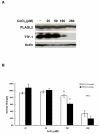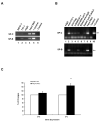PLAGL2 translocation and SP-C promoter activity--a cellular response of lung cells to hypoxia
- PMID: 17618602
- PMCID: PMC2084061
- DOI: 10.1016/j.bbrc.2007.06.106
PLAGL2 translocation and SP-C promoter activity--a cellular response of lung cells to hypoxia
Abstract
Cobalt is a transition metal which can substitute for iron in the oxygen-sensitive protein and mimic hypoxia. Cobalt was known to be associated with the development of lung disease. In this study, when lung cells were exposed to hypoxia-induced by CoCl(2) at a sub-lethal concentration (100 microM), their thyroid transcription factor-1 (TTF-1) expression was greatly reduced. Under this condition, SP-B promoter activity was down-regulated, but SP-C promoter remained active. Therefore, we hypothesized that other factor(s) besides TTF-1 might contribute to the modulation of SP-C promoter in hypoxic lung cells. Pleomorphic adenoma gene like-2 (PLAGL2), a previously identified TTF-1-independent activator of the SP-C promoter, was not down-regulated, nor increased, within those cells. Its cellular location was redistributed from the cytoplasm to the nucleus. Chromatin immunoprecipitation (ChIP) and quantitative RT-PCR analyses demonstrated that nuclear PLAGL2 occupied and transactivated the endogenous SP-C promoter in lung cells. Thereby, through relocating and accumulating of PLAGL2 inside the nucleus, PLAGL2 interacted with its target genes for various cellular functions. These results further suggest that PLAGL2 is an oxidative stress responding regulator in lung cells.
Figures




References
-
- Kelly SE, Bachurski CJ, Burhans MS, Glasser SW. Transcription of the lung-specific surfactant protein C gene is mediated by thyroid transcription factor 1. J Biol.Chem. 1996;271:6881–6888. - PubMed
-
- Bohinski RJ, Di Lauro R, Whitsett JA. The lung-specific surfactant protein B gene promoter is a target for thyroid transcription factor 1 and hepatocyte nuclear factor 3, indicating common factors for organ-specific gene expression along the foregut axis. Mol.Cell Biol. 1994;14:5671–5681. - PMC - PubMed
-
- Yang MC, Weissler JC, Terada LS, Deng F, Yang YS. Pleiomorphic Adenoma Gene-Like-2, a Zinc Finger Protein, Transactivates the Surfactant Protein-C Promoter. Am.J.Respir.Cell Mol.Biol. 2005;32:35–43. - PubMed
-
- Kas K, Voz ML, Hensen K, Meyen E, Van de Ven WJ. Transcriptional activation capacity of the novel PLAG family of zinc finger proteins. J.Biol Chem. 1998;273:23026–23032. - PubMed
-
- Hensen K, Van Valckenborgh IC, Kas K, Van de Ven WJ, Voz ML. The tumorigenic diversity of the three PLAG family members is associated with different DNA binding capacities. Cancer Res. 2002;62:1510–1517. - PubMed
Publication types
MeSH terms
Substances
Grants and funding
LinkOut - more resources
Full Text Sources

